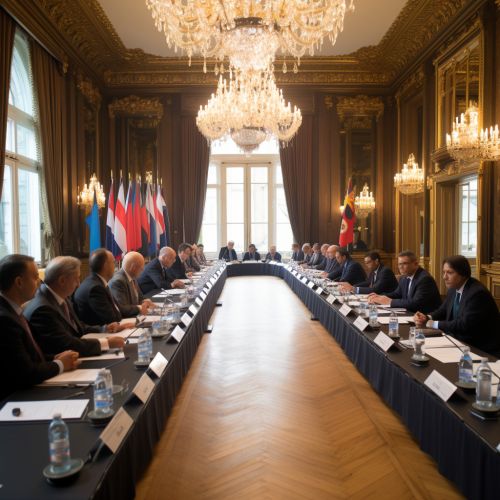General Agreement on Tariffs and Trade
History
The General Agreement on Tariffs and Trade (GATT) was established in 1947 as a multilateral agreement regulating international trade. Its primary purpose was to reduce trade barriers, such as tariffs, and to provide a common ground for trade negotiations. The agreement was signed by 23 countries, including major economic powers such as the United States of America, the United Kingdom, and France. The GATT was intended to be a temporary measure until the establishment of the International Trade Organization (ITO), but when plans for the ITO were abandoned, the GATT became the primary international mechanism for regulating trade until the establishment of the World Trade Organization (WTO) in 1995.


Principles
The GATT was based on several fundamental principles. The first, and perhaps most important, was the principle of non-discrimination. This was embodied in the Most-Favoured-Nation (MFN) clause, which stipulated that any advantage, favour, privilege, or immunity granted by a contracting party to any product originating in or destined for any other country must be immediately and unconditionally accorded to the like product originating in or destined for all other contracting parties. This principle was intended to prevent the creation of preferential trading blocs and to ensure equal trading conditions for all signatories.
The second principle was that of transparency. This was achieved through the publication of tariffs and other trade measures, and through the requirement for member countries to notify the GATT of changes to trade policies. This was intended to provide certainty and predictability for international traders.
The third principle was that of negotiation. The GATT provided a forum for member countries to negotiate reductions in trade barriers. These negotiations took place in rounds, the most significant of which were the Kennedy Round (1964-1967), the Tokyo Round (1973-1979), and the Uruguay Round (1986-1994).
Impact
The GATT had a significant impact on international trade. By providing a forum for negotiation and a mechanism for the enforcement of trade rules, it helped to reduce trade barriers and to increase the volume of international trade. However, the GATT was not without its critics. Some argued that it was biased in favour of developed countries and against developing countries. Others argued that it was insufficiently transparent and that it failed to address important issues such as trade in services and intellectual property rights.
Legacy
The GATT was replaced by the WTO in 1995, but its principles and many of its provisions were incorporated into the new organization. The WTO has a broader scope than the GATT, covering not only trade in goods but also trade in services and intellectual property rights. However, the principles of non-discrimination, transparency, and negotiation remain at the heart of the international trading system.
